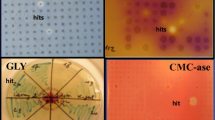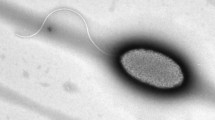Abstract
From genomic libraries of purple sulphur bacteria, fragments were cloned that encoded for proteins involved in the synthesis of poly(3-hydroxyalkanoic acids), PHA. A 12.5- and a 15.0- plus a 15.6-kbp EcoRI-restriction fragment of Ectothiordospira shaposhnikovii of Thiocapsa pfennigii, respectively, which hybridized with a fragment encoding the Alcaligenenes eutrophus PHA-biosynthesis operon, were identified in δL47 libraries, whereas an 18.0-kbp EcoRI fragment of Lamprocytis roseopersicina, which phenotypically complemented a PHA-neagative mutant of A. eutrophus, was identified in a pVK100 cosmid library. Hybridization studies and enzymatic analysis of crued extracts derived from transconjugants of Escherichia coli and A. eutrophus harbouring these fragments revealed the presence of the genes for NADH-dependent acetoacetyl-CoA reductase and/or PHA synthase. The PHA-biosynthesis genes of T. pfennigii and L. roseopersicina as wells as of Chromatium vinosum, Thiocystis violacea, Rhodospirillum rubrum and Rodobacter sphaeroides were then analysed for thire ability to confer synthesis of PHA other poly(3-hydroxybutric acid) to PHA-negative mutants of PHA-accumulating bacteria. The most striking result was that a fragment harbouring the PHA-synthase gene of T. pfennigii conferred the ability to synthesize a polymer consisting of almost equimolar amounts of 3-hydroxybutyrate (48.5 mol%) and 3-hydroxyhexanote (47.3%) plus a small amount of 3-hydroxyoctanoate (4.2 mol %) to a PHA-negative mutant of Pseudomonas putida. A niosynthetic polyester with this composition has not been described before.
Similar content being viewed by others
References
Biebl H, Pfennig N (1978) Grwoth yields of green bacteria in mixed cultures with sulfur and sulfate reducing bacteria. Arch Microbiol 117:9–16
Brandl H, Gross RA, Lenz RW, Fuller RC (1988) Pseudomonas oleovorans as a source of poly(β-hydroxyalkanoates) for potential applications as biodegradable polyesters. Appl Environ Microbiol 54:1977–1982
Friedrich B, Hogrefe C, Schlegel HG (1981) Naturally occuring genetic transfer if hydrogen-oxidizing between strains of ALcaligenes eutrophus. J Bacteriol 147:198–205
Hanahan D (1983) Studies on transformation of EScherichia coli with plasmids. J Mol Biol 166:557–580
Haywood GW, Anderson AJ, Williams DR, Dawes EA, Ewing DF (1991) The accumulation of a polyhydroxyalkanoate copolymer containing primarily 3-hydroxyvalerate from simple carbohydrate substrates by Rhodococcus sp. NCIMB 40126. Int J Biol Macrobol 13:83–88
Hohn B, Collins J (1980) A small cosmid for efficient cloning of large DNA fragments. Gene 11:291–298
Huisman GW, Wonink E, Meima R, Kazemier B, Terstra P, Witholt B (1991) Metabolism of poly(3-hydroxyalkanoates) by Pseudomonas oleovorans: identification and sequences of genes and function of the encoded portein in the synthesis and degradation of PHA. J Biol Chem 266:2191–2198
Hustede E, Steinbüchel A, Schlegel HG (1992) Cloning of poly(3-hydroxybutyric acid) synthase of Rhoobacter sphaeroides and Rhodospirillum rubrum and heterologous expression in Alcaligenes eutrophus. FEMS Microbiol Lett 93:295–290
Imhoff JF (1988) Anoxygenic phototrophic bateria. In: Austin B (ed) Methods in aquatic bateriology. Wiley, New York, pp 207–240
Knauf VC, Nester EW (1982) Wide host range sloning vetors: a cosmid clone bank of an Bacterium Ti plasmid. Plasmid 8:45–54
Liebergesell M, Steinbüchel A (1992) Cloning and nucleotide sequences of genes relevevant for biosynthesis of poly(3-hydroxybutyric acid) in Chroromatium vinosum strain D. Eur J Biochem 209:135–150
Liebergesell M, Steinbüchel A (1993) Cloning and molecular analysis of the poly(3-hydroxybutyric acid) biosynthetic genes of Thiocystis violacea. Appl Microbiol Biotechnol 38:493–501
Liebrgesell M, Timm A, Hustede E, Steinbüchel A, Fuller RC, Lenz RW, Schlegel HG (1991) Formation of poly(3-hydroxylakanoates) by phototrophic and chemolithotropic bacteria. Arch Microbiol 155:415–521
Loenen WAM, Brammar WJ (1980) A bacteriophage lambda vector for cloning large fragments made with several rsetriction enzymes. Gene 10:249–259
Lowry OH, Rosenbrough NJ, Fall AL, Randall RJ (1951) Protein measurement with the Folin phenol reagent. J Biol Chem 193:265–275
Lynen F, Wieland H (1955) β-Ketoreductase. Methods Enzymol 1:566–573
Mandel M, Leadbetter ER, Pfennig N, Trüper HG (1971) Deoxyribonucleic acid base composition of phototrophic bacteria. Int J Syst Bact 21:222–230
Nishimura T, Saito T, Tomita K (1978) Purification and properties of β-ketothiolase from Zoogleoa ramigera. Arch Microbiol 116:21–27
Oelmüller E, Krüger N, Steinbüchel A, Friedrich CG (1990) Isolation of prokaryotic RNA and detection of specific mRNA with biotinylated probes. J Microbiol Methods 11:73–81
Pries A, Pfriefert H, Krüger N, Steinbüchel A (1991) Identification and characterization of two Alcaligenes eutrophus gene loci relevant to the poly(β-hydroxybutyric acid)-leaky phenotype which exhibit homology to ptsH and pstI of Echerichia coli. J Bacteriol 173:5843–5853
Smabrook J, Fritsch EF, Maniatis T (1989) Molecular cloning:a ;aboratory manual, 2nd edn. Cold Spring Harbor Laboratory, Cold Spring Harbor, N.Y.
Schlegel HG, Kaltwasser H, Gottschalk G (1961) Ein Subsmersverfahren zur Kultur wasserstoff-oxidierender Bakterien: Wachtumsphyciologische Untersuchungen. Arch Mikrobiol 38:209–222
Schlegel HG, Lafferty R, Krauss I (1970) The isolation of mutants not accumulating polyβ-hydroxybutric acid. Arch Mikrobiol 71:283–294
Schubert P (1990) Molekulare Organisation des PHB-Operons und Characterisier des PHB-Synthasegens in Alcaligenes eutrophus. Ph. D. thesis, Georg-August Universität Göttingen
Schubert P, Steinbüchel A, Schlegel HG (1988) Cloning of the Alcaligenes eutrophus genes for the synthesis of polyβ-hydroxybutyric acid (PHB) and synthesis of PHB in Escherichia coli. J Bacteriol 170:5837–5847
Schubert P, Krüger N, Steinbüchel A (1991) Molecular analysis of the Alcaligenes eutrophus poy(3-hydroxybutyrate)-, PHB-,biosynthesis operon: identification of the N-terminus of PHB synthase and identification of the promoter. J Bacteriol 173:168–175
Simon R, Priefer U, Pühler A (1983) A broad host range mobilization system for in vivo genetic engineering: transporon mutagenesis in Gram-negative bacteria. Bio/Technology 1:784–791
Spurr AR (1969) A low-viscosity epoxy resin embedding medium for electron microscopy. J Ultrastruct Res 26:31–43
Steinbüchel A (1991) Polyhydroxyalkanoic acids. In: Byrom D (ed) Biomaterials. Macmillan, New York, pp 123–213
Steinbüchel A, Schlegel HG (1991) Physiology and molecular genetics of poly(β-hydroxylakanoic acid) synthesis in Alcaligenes eutrophus. Mol Microbiol 5:535–542
Steinbüchel A, Krüger N, Valentin H, Timm A, Pries A, Hustede E Schlegel HG (1991) Physiological and genetical analysis of polyhydroxyalkanoate biosynthetic pathways. In: Galli E, Silver S, Witholt B (eds) Pseudomonas: molecular biology and biotechnology. American Society for Microbiology, Washington, D.C., pp 315–327
Steinbüchel A, Hustede E, Liebergesell M, Pieper U, Timm A, Valentin H (1992) Molecular basis for biosythesis and accumulation of polyhydroxyalkanoic acids in bacteria. FEMS Microbiol Rev 103:217–230
Timm A, Byrom D, Steinbüchel A (1990) Formation of blends of various poly(3-hydroxyalkanoic acids) by recombinant strain of Pseudomonas oleovorans. Appl Microbiol Biotechniol 33:296–301
Trüper HG (1968) Ectothiorhodospira mobilis Pelsh, a phototrophic sulfur bacterium depositing sulfur outside the cells. J Bacteriol 95:1910–1920
Vogelstein B, Gillespie D (1979) Preparative and analytical purification of DNA from agarose. Proc Natl Acad Sci USA 76:615–619
Walther-Mauruschat A, Aragno M, Mayer F, Schlegel HG (1977) Micromophology of Gram-negative hydrogen bacteria. II. Cell envelope, membranes, and cytoplasmatic inclusions. Arch Microbiol 114:101–110
Author information
Authors and Affiliations
Additional information
Correspondence to: A. Steinbüchel
Rights and permissions
About this article
Cite this article
Liebergesell, M., Mayer, F. & Steinbüchel, A. Anaylsis of polyhydroxyalkanoic acid-biosynthesis genes of anoxygenic phototrophic bacteria reveals synthesis of a polyester exhibiting an unusal composition. Appl Microbiol Biotechnol 40, 292–300 (1993). https://doi.org/10.1007/BF00170383
Received:
Accepted:
Issue Date:
DOI: https://doi.org/10.1007/BF00170383




